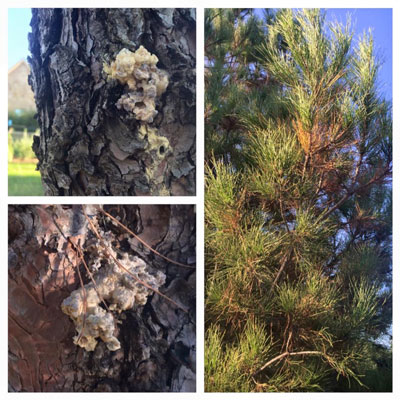Question of the Week – Number One: May 28, 2020
“I have two Eldarica pines that are about 15 years old. They seem to be failing. They’re part of a privacy screen – a row of seven trees. I don’t want to lose them. Their needles are turning brown and resin is forming on their trunks. Help!”
When Eldarica pines (Pinus eldarica), also known as Afghan pines and Mondell pines, were introduced to Texas more than 40 years ago, we rejoiced. Suddenly we had a species of pine that was adapted to both arid conditions and also alkaline soils like most of us in the western 80 percent of Texas have. It seemed like a marriage made in horticultural heaven.
But as the trees became semi-mature we started to see them fail. In most cases, at least in my own observations, most of the losses happened a year or two after extremely wet summers. It almost seemed like these plants that were equipped to handle drought couldn’t hold up to prosperity.

There are probably pathogens involved as well, most likely Diplodia Tip Blight (Sphaeropsis sapinea). And, unfortunately, there isn’t anything we can do to stop the downhill slide. I’ve heard about the problem all along the I-35 corridor through the middle of the state, but surprisingly also in far West Texas as well. Most of us quit recommending the plant altogether.
So, at this point I’m prepared to suggest one of the larger junipers instead. For most of the eastern half of the state that would be eastern redcedar juniper (Juniperus virginiana), native to most of that region. There are other junipers in the Hill Country and West Texas such as Ashe juniper*, or you could use live oaks or one of the southern magnolia cultivars. Nellie R. Stevens hollies will grow tall enough to provide privacy, but it will take them longer than most people would be willing to wait. Stay away from Leyland cypress, however. It’s highly susceptible to fatal disease problems – more so even than the Eldarica pines.
*Eastern redcedar and Ashe juniper are both in the class of “mountain cedars” that cause so many people allergic reactions in late winter and early spring. My wife is one such. In defense of my even suggesting it as a screening plant, let me say that if you’re in an area where there are already thousands of them, adding a few more probably won’t increase the chances of allergic reactions by very much. They’re great plants that fit right into their surroundings. But that’s a decision you have to make for yourself.
